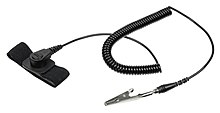
Back جهاز مضاد الكهروستيتكي Arabic Антистатично устройство Bulgarian Antistatisk materiale Danish Dispositivo antiestático Spanish 防靜電裝置 Chinese

An antistatic device is any device that reduces, dampens, or otherwise inhibits electrostatic discharge, or ESD, which is the buildup or discharge of static electricity.[1][2] ESD can damage electrical components such as computer hard drives, and even ignite flammable liquids and gases.
Many methods exist for neutralizing static electricity, varying in use and effectiveness depending on the application. Antistatic agents are chemical compounds that can be added to an object, or the packaging of an object, to help deter the buildup or discharge of static electricity.[3] For the neutralization of static charge in a larger area, such as a factory floor, semiconductor cleanroom or workshop, antistatic systems may utilize electron emission effects such as corona discharge or photoemission that introduce ions into the area that combine with and neutralize any electrically charged object.[4] In many situations, sufficient ESD protection can be achieved with electrical grounding.
- ^ "What is antistatic device?". www.computerhope.com. Retrieved 2016-01-20.
- ^ Woodford, Chris (14 March 2009). "How do anti-static products work? - Explain that Stuff". www.explainthatstuff.com. Retrieved 2016-01-20.
- ^ Allen, Ryne C. (August 1999). "ESD BAGS: TO SHIELD OR NOT TO SHIELD". EE-Evaluation Engineering. Retrieved 2017-07-02.
- ^ "Ionizers and Static Eliminators Information". IEEE GlobalSpec. Retrieved 2017-07-02.
© MMXXIII Rich X Search. We shall prevail. All rights reserved. Rich X Search